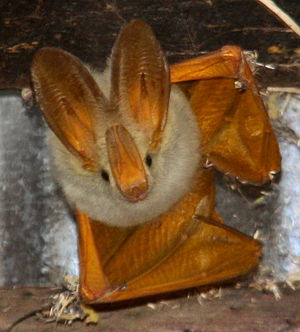Yellow-winged bat
| Yellow-winged bat | ||||||||||||
|---|---|---|---|---|---|---|---|---|---|---|---|---|

Yellow-winged bat ( Lavia frons ) |
||||||||||||
| Systematics | ||||||||||||
|
||||||||||||
| Scientific name of the genus | ||||||||||||
| Lavia | ||||||||||||
| JE Gray , 1838 | ||||||||||||
| Scientific name of the species | ||||||||||||
| Lavia frons | ||||||||||||
| ( É. Geoffroy , 1810) |
The yellow-winged bat ( Lavia frons ) is a species of bat from the family of large-leaf noses (Megadermatidae). Their distribution area includes central Africa and ranges from Gambia to Ethiopia and south to Zambia .
description
As its name suggests, the wings of this bat species are yellowish-red in color, as are the long ears. The color of the rest of the body varies from light gray to gray-blue. As with all large-leaf noses, the nasal blade is very large and also ends at the lower end in a tip protruding forward. These animals reach a head body length of 60 to 80 millimeters, a wingspan of around 35 centimeters and a weight of 28 to 36 grams.
Way of life
Yellow-winged bats live in forests and open, tree-lined areas, mostly near bodies of water such as swamps, rivers, and lakes. In contrast to the other large-leaf noses, they prefer trees as sleeping places, which means that they are very alert and relatively active during the day. They rarely close their eyes and keep fluttering away from potential dangers.
Yellow-winged bats, unlike most bat species, form monogamous relationships. A male and a female establish their own resting place, at least 20 meters away from the next couple. The male protects his female, especially during breastfeeding, it flies again and again through the 0.6 to 0.8 hectare large territory to drive away conspecifics and to warn of predators (mainly birds of prey and snakes ). Mutual grooming was also observed in these animals.
food
In contrast to the other large-leaf noses, yellow-winged bats are pure insectivores. At dusk and dawn, usually when there is more light than many other bats, they go in search of food. To do this, they hang on branches and look out. If they have discovered a prey, they pounce on it and fly back to their tree to eat it there.
Reproduction
These animals know courtship rituals like common flights in which the partners circle each other. In April, at the beginning of the rainy season, a single young is usually born. The newborn clings to a pair of pseudo-teats near the anus and is taken along on the mother's forays out into the field. After about a month, it begins with independent flight attempts and is weaned about 20 days later. It then stays in the parents' area for another 30 days before finally leaving.
threat
Yellow-winged bats are common and widespread and are not listed as threatened.
literature
- Ronald M. Nowak: Walker's Mammals of the World . Johns Hopkins University Press, 1999 ISBN 0801857899
Web links
- Lavia frons inthe IUCN 2013 Red List of Threatened Species . Posted by: Mickleburgh, S., Hutson, AM & Bergmans, W., 2008. Retrieved December 28, 2013.